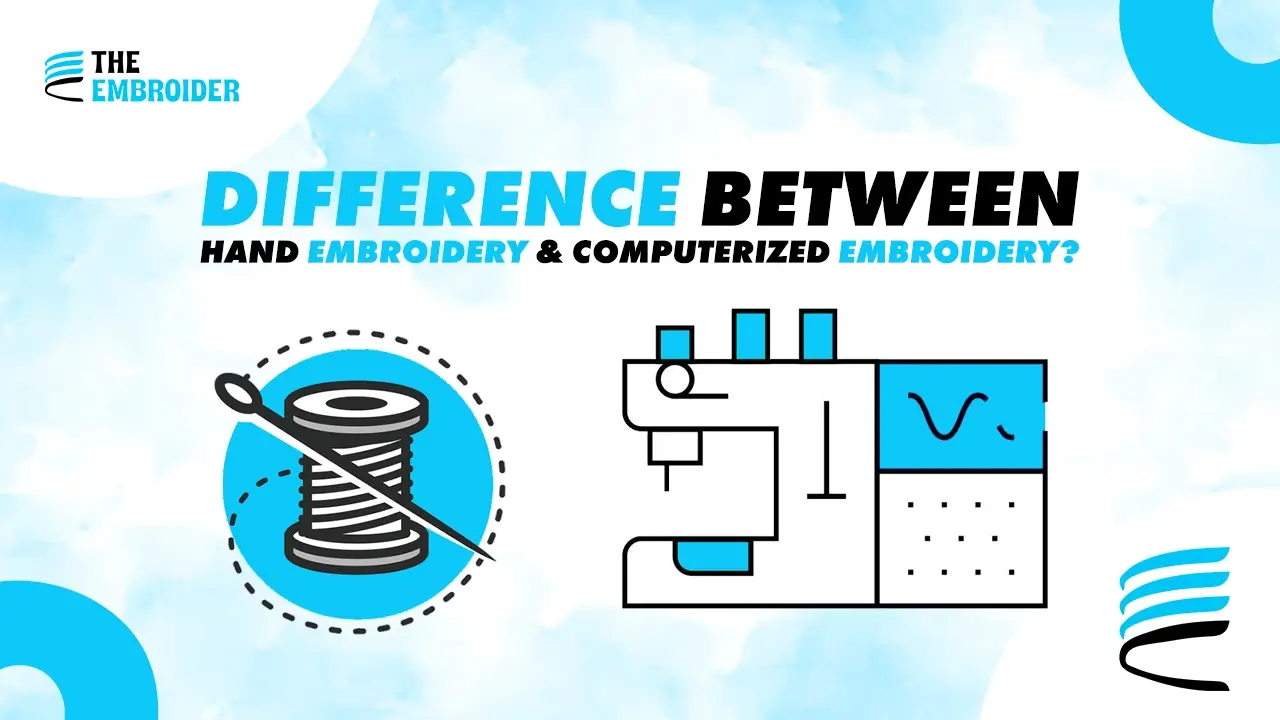There are different types of embroidery art. In the past, it was done manually with needles, threads, and frames. Now, it has modernized and can be done with the help of computer commands. However, by just looking at an embroidery logo you can’t comment if it’s hand embroidery or computerized embroidery. Thus, many people want to know the difference between both embroidery types.
In simple words, handmade embroidery is manually designed and threaded art. In contrast, computerized embroidery is embroidery done via automated machines. These machines work on digital designs that provide commands to bring computer-designed artwork to life.
In addition to the embroidery process, there are several differences between hand embroidery and machine embroidery. So, if you want to decide which one you should opt for your next embroidery task, keep reading to understand the difference between hand embroidery and computerized embroidery.
Handmade vs. Computerized Embroidery:
Choosing an embroidery process is the first step in bringing out your favorite design over your t-shirt, jacket back, or cap. It determines the time it will take to process, the pre-embroidery steps, and many other details. Therefore, before choosing an embroidery process you must understand the difference between each process. So, Let’s explore these embroidery methods, see how they’re different, and understand what’s good about each.
Embroidery Process:
Handmade embroidery is all about crafting each stitch by hand, showing skill and dedication. Moreover, its process consists of multiple steps:
- Right hoop/frame,
- Design Tracing
- Choosing the right needle
Besides a tiring process, Handmade embroidery often exhibits a variety of stitches, showcasing the artisan’s skill and creativity. The skilled embroiderer can do different stitch types, such as satin stitch, chain stitch, or cross-stitch, within the design.
On the other hand, computerized embroidery uses machines to sew. It uses specialized “digitizing” Embroidery software. Its process includes:
- It starts with creating or getting a digital design file for embroidery.
- You can make changes to the embroidery pattern as needed.
- The design must include thread colors, thread densities, stitch length, and stitch type to instruct the machine
- Then, you are required to load the design file into the embroidery machine.
- Lastly, just place the fabric on the machine. However, fabric stability is important for a flawless design.
Machines follow clear instructions given by computers and quickly bring designs to life. It creates uniform, and identical designs and offers limited thread variations and a more artificial look. Besides, most machines rely on a specific set of stitches defined in the pre-made patterns.
Threads and Materials:
Hand embroidery uses threads like cotton or silk, which can bring beautiful shading details to your fabric. Different thread thicknesses enhance the art.
Besides, computerized embroidery often uses synthetic threads like rayon or polyester, which can give the design a more artificial look and uniform sheen. However, only a few machines can do cotton or silk-based threads and it poses significant difficulties.
Uniqueness:
Handmade embroidery is like painting with threads. People can use different threads and styles to create many handmade designs. Additionally, they easily use delicate materials that machines can’t.
Conversely, computerized embroidery services replicates designs as programmed, you can’t bring variability between embroidery processes. Because if you want to change in the middle you will have to re-digitize the design. So, it’s good at being accurate and fast, but it can’t be as creative as handmade embroidery.
Difficulty Level:
A manual process is always difficult and energy-draining compared to a computer operated. Similarly, handmade embroidery is a time-consuming task that’s not very easy to perform. The embroiderer needs to fix the fabric in wooden frames and needle each stitch accurately over the traced design. Still, anyone can learn hand embroidery and apply it to their dresses themselves with the help of YouTube trainers.
In contrast, for machine embroidery, you digitize the design on the computer. It includes vector tracing, thread color, hoop size, and thread thickness selection. And when it’s done the computer does it easily within minutes. Besides, you can’t do it at home. You need special computer literacy and skills to understand what is embroidery digitizing and purchase expensive modern machines. So, both have their limitations and difficulties.
Applications: Where Each Method Excels:
Handmade embroidery adds a personal touch to items, making it perfect for special clothes, couture, and heirlooms. It’s loved for its special details and personalized work.
Computerized embroidery is great for businesses and making many things quickly. It’s good for repeating designs fast.
Pitfalls and Considerations:
Handmade embroidery takes time and may not work for projects with tight deadlines. It also can’t be scaled up easily to produce large quantities quickly.
While computerized embroidery might not have the same personal touch and creativity as handmade work. It also depends on machine performance and has limitations in using certain materials.
Which Is Best?
The choice between hand and machine embroidery depends on your goal.
Hand Embroidery: Ideal for creating unique designs or personalized artworks. Requires time, skill, and heart.
Machine Embroidery: Produces professional-looking work efficiently. Offers a wide range of designs for personal and business use.
Conclusion:
Both handmade and computerized embroidery have unique qualities. Even though hand embroidery has cultural importance, it’s a slow and difficult process. In contrast, computerized embroidery is a simple and fast-paced process. It only needs embroidery digitizing and feeding the design to the automatic machines and your work is done within seconds. A bad embroidery digitizing and clipping path services can destroy your final computerized design. So, connect with “The Embroider” now and get a quick and customized embroidery digitizing service. We offer t-shirt digitizing, logo digitizing and many other services for your ease.

